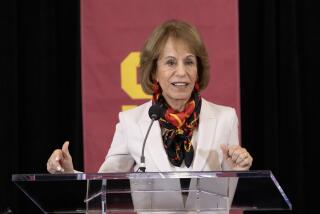Departing San Diego State president leaves a long, distinguished legacy
- Share via
Reporting from San Diego — Stephen Weber says he’ll miss walking across the campus of San Diego State when he retires in a few weeks and moves to coastal Maine.
Small wonder.
The sun-splashed campus on a plateau that locals call Montezuma Mesa is, to a large degree, a reflection of Weber’s 15 years as president.
Beyond the new construction and landscaping, and the fact that a great number of faculty members were hired during Weber’s tenure, there have been significant changes in the curriculum, student achievement levels and the university’s involvement with its host city.
Research funding is up, private fundraising is up, the grade-point average of incoming freshmen is up, and the percentage of students who graduate in four years has increased from 38% to 66%.
Plus: the football and basketball teams have just enjoyed highly successful seasons under coaches hired by Weber. Even in years when losing seemed to be a habit for Aztec teams, Weber was there as Fan No. 1.
With the average university president lasting about six years, Weber’s long tenure “is exceptional” said R. Michael Tanner, chief academic officer of the Assn. of Public and Land-grant Universities.
Weber’s longevity, Tanner said, shows that he has succeeded in that most difficult of tasks: satisfying the needs and demands of the media, the faculty Senate, the California State University trustees, the alumni and the local community.
At 69, Weber is retiring with his wife, Susan, to a cabin in Maine where he started his academic career four decades ago. He had wanted to retire at 65 but was persuaded by faculty members and others to stay four more years.
Weber said he is proud of his accomplishments but disappointed that he was unable to do more to improve K-12 education in San Diego. He’s also worried about a drift in political support for higher education in California.
Elliot Hirshman, provost and senior vice president of the University of Maryland, Baltimore County, will succeed Weber as the president of the 30,000-student campus.
Hirshman inherits a campus that, like many others, has been hit by reductions in state financial support, enrollment freezes and rising tuition — all of which Weber warns are counter-productive amid a national recession.
“California is going to come back, and we’ve got to be ready for it to come back,” he said. “There’s so much that could be done if we had the will.”
In partnership with a project funded by philanthropist Sol Price, San Diego State runs three public schools in the inner-city neighborhood of City Heights. The university assumed control only after reaching an agreement with the teachers union.
“We didn’t want a hostile takeover,” Weber said. While the program has boosted achievement in some areas, mathematics still lags, to Weber’s dismay.
If there is a Weber style, it’s long on collaboration, according to academics and community leaders who have worked with him.
Weber’s predecessor had a reputation for top-down management, to the annoyance of faculty members. Weber was determined to use a different approach, arriving in San Diego in 1996 after a year as interim provost for academic affairs at the State University of New York system and eight years as president of SUNY’s Oswego campus.
Bill Snavely, director of San Diego State’s School of Communication and chairman of the University Senate, said Weber “believes in working with all segments of the university.… We will all miss Steve Weber’s steady hand.”
San Diego State has long had a close relationship with the business and political leadership of San Diego. All five members of the Board of Supervisors attended San Diego State; three of the last four mayors have had ties to the campus.
Julie Meier Wright, president of the San Diego Regional Economic Development Corp., said Weber sought advice from business leaders on what kind of education they needed for their workforce, particularly in sectors key to San Diego’s economy: engineering, bio-technology and the hospitality industry. From that advice came curriculum changes, she said.
“He made the university extremely relevant to the business community,” she said. “He has a calm, thoughtful approach to things that belies a significant amount of passion he has.”
One of Weber’s passions has been making San Diego State supportive of military veterans. More than 1,000 veterans are enrolled; the university opened the first veterans center in the Cal State system; all applications from veterans are reviewed by a retired military officer.
When Weber arrived, San Diego State had 60 students studying abroad. Today there are 1,800, as students are encouraged to consider careers in international business.
“Students are opportunity-seeking missiles,” Weber said.
Under the California Master Plan for Higher Education, state universities are still designed to be predominantly a place for undergraduates. But San Diego State has pushed that envelope and now offers 16 joint-doctoral programs.
In a few weeks, the Webers will move to their home in Hancock Point, Maine, about 40 miles south of Bangor. It was their home when, with a fresh doctorate in philosophy from Notre Dame, Weber was on the faculty of the University of Maine.
There will be traveling — first to New Zealand and Australia — and a couple of months each winter in San Diego. And there may be reflections on the many tasks that confront a university president in the modern era.
“It’s a really good job for persons with a short attention span,” he said.
More to Read
Sign up for Essential California
The most important California stories and recommendations in your inbox every morning.
You may occasionally receive promotional content from the Los Angeles Times.










